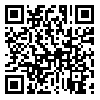BibTeX | RIS | EndNote | Medlars | ProCite | Reference Manager | RefWorks
Send citation to:
URL: http://jccnc.iums.ac.ir/article-1-602-en.html


 , Ayman M. Al-Qaaneh *2
, Ayman M. Al-Qaaneh *2 

 , Kholood E. Al-Nbabteh3
, Kholood E. Al-Nbabteh3 
 , Eslam H. Bani Mohammad4
, Eslam H. Bani Mohammad4 

 , Jumana H. Shehadeh5
, Jumana H. Shehadeh5 

2- Department of Allied Health Sciences, Faculty of Nursing, Al-Balqa Applied University (BAU), Al-Salt, Jordan. ,
3- Department of Midwifery, Faculty of Nursing, Al-Balqa Applied University (BAU), Al-Salt, Jordan.
4- Department of Nursing, Faculty of Nursing, Al-Balqa Applied University (BAU), Al-Salt,, Jordan.
5- Department of Community Nursing, School of Nursing, The University of Jordan, Amman, Jordan.
Background: Physical restraint (PR) is one of the most common methods nurses use to reduce patient movement, especially in intensive care units (ICUs); however, PR is considered one of the undesirable methods due to its related clinical and ethical issues. This study investigates Jordanian nurses’ knowledge, attitudes, and practices regarding using PR, its alternatives in different ICUs, and its associated factors.
Methods: This was a descriptive-cross-sectional study, conducted in the ICUs of four different hospitals in Jordan from October 2023 to March 2024. A convenience sample of 240 ICU nurses was recruited to fill out a self-administered PR questionnaire. The data were analyzed using an independent sample t-test, analysis of variance, and the Pearson correlation coefficient using the SPSS software, version 25. All conducted tests were two-tailed and considered significant when the P<0.05.
Results: The results revealed moderate knowledge (11.1±2.46), positive attitude (27.04±3.35) and good practice (37.19±3.33) regarding the use of PR. Receiving training on the use of PR had a direct significant relationship with the use of alternative methods before PR in the patients (P<0.001) and the total practice score (P=0.049). The presence of PR as part of the new hire orientation program and the number of times of using PR had a significant association with the use of alternatives before PR for the patients (P<0.0001 and P=0.043, respectively). In terms of total knowledge (P=0.01), use of alternatives (P=0.025) and practice (P<0.001) regarding the use of PRs, accredited hospitals were at a higher level, but the difference in nurses’ attitudes was not significant (P=0.839). There was a significant difference in terms of total alternatives (P=0.016), attitude (P<0.001), and practice (P=0.02) depending on the type of ICU. There were other significant relationships between the main variables among which the relationship between total knowledge and total practice (r=0.434, P<0.01), and total use of alternatives and total practice (r=0.43, P<0.01) were more powerful.
Conclusion: The current study indicates variations in nurses’ knowledge levels, attitudes, and practices across different ICUs and hospital types. These findings emphasize the importance of in-service education as a golden role in improving nurses’ knowledge levels and practices toward PR. The journey to accreditation in the management of hospitals by nursing managers and policymakers has a positive impact on improving nursing knowledge and skills regarding PR application and enhancing patient safety and care outcomes.
Received: 2024/04/9 | Accepted: 2024/08/8 | Published: 2025/02/1
| Rights and permissions | |
 |
This work is licensed under a Creative Commons Attribution-NonCommercial 4.0 International License. |



